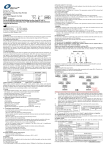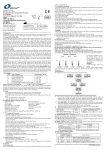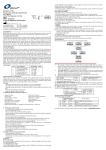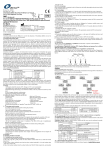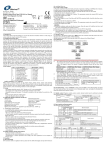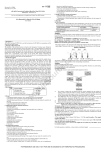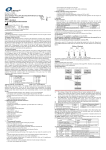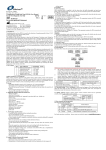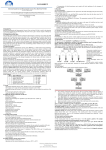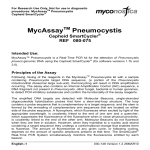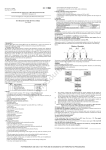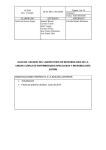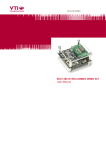Transcript
Revision No.: ZJ0004 Issue Date: Feb 9th, 2009 Pneumocystis Carinii Real Time PCR Kit Cat. No.: QD-0082-01 For Use with LightCycler 1.0/LightCycler2.0 Real Time PCR Systems For In Vitro Diagnostic Use Only User Manual European Authorized Representative (E.A.R.) Obelis S.A. 34 Av. De Tervuren, bte 44 B-1040 Brussels , Belgium Phone : +32.2.732.59.54 Fax : +32.2.732.60.03 E-mail : [email protected] Shanghai ZJ Bio-Tech Co., Ltd. Manufactured by www.liferiver.com.cn Tel: +86-21-51320182 [email protected] Fax: +86-21-51320183 No.720 Cailun Road Zhangjiang High Technology Park, Shanghai, China 1. Intended Use Pneumocystis Carinii real time PCR kit is used for the detection of Pneumocystis Carinii in bronchial lavage sample or lung section sample by using real time PCR systems. 2. Principle of Real-Time PCR The principle of the real-time detection is based on the fluorogenic 5’nuclease assay. During the PCR reaction, the DNA polymerase cleaves the probe at the 5’ end and separates the reporter dye from the quencher dye only when the probe hybridizes to the target DNA. This cleavage results in the fluorescent signal generated by the cleaved reporter dye, which is monitored real-time by the PCR detection system. The PCR cycle at which an increase in the fluorescence signal is detected initially (Ct) is proportional to the amount of the specific PCR product. Monitoring the fluorescence intensities during Real Time allows the detection of the accumulating product without having to re-open the reaction tube after the amplification. 3. Product Description Pneumocystis pneumonia (PCP) is a form of pneumonia caused by the yeast-like fungus, Pneumocystis jirovecii . The causal agent was originally described as a protozoan and spelled P. jiroveci and prior to then was classified as a form of Pneumocystis carinii, a name still in common usage. These names are discussed below. As a result, Pneumocystis pneumonia (PCP) has also been known as Pneumocystis jirovecii pneumonia and as Pneumocystis carinii pneumonia. Pneumocystis Carinii real time PCR kit contains a specific ready-to-use system for the detection of the Pneumocystis Carinii by polymerase chain reaction in the real-time PCR system. The master contains reagents and enzymes for the specific amplification of the Pneumocystis Carinii DNA. Fluorescence is emitted and measured by the real time systems´ optical unit. The detection of amplified Pneumocystis Carinii DNA fragment is performed in fluorimeter channel FAM with the fluorescent quencher BHQ1. DNA extraction buffer is available in the kit and bronchial lavage sample or lung section sample is used for the extraction of the DNA. In addition, the kit contains a system to identify possible PCR inhibition by measuring the HEX/VIC/JOE fluorescence of the internal control (IC).An external positive control (1×108copies/ml) contained, allows the determination of the gene load. For further information, please refer to section 9.3 Quantitation. 4. Kit Contents Ref. Type of Reagent Presentation 25rxns 1 DNA Extraction Buffer 2 vials, 1.5ml 2 P. Carinii Reaction Mix 1 vial, 450µl 4 PCR Enzyme Mix 1 vial, 12µl 5 Molecular Grade Water 1 vial, 400µl 6 Internal Control (IC) 1 vial, 30µl 8 7 P. Carinii Positive Control (1×10 copies/ml) 1 vial, 30µl 5. Storage • All reagents should be stored at -20°C. Storage at +4°C is not recommended. • All reagents can be used until the expiration date indicated on the kit label. • Repeated thawing and freezing (>3x) should be avoided, as this may reduce the sensitivity of the assay. • Cool all reagents during the working steps. • Super Mix should be stored in the dark. 6. Additionally Required Materials and Devices • Biological cabinet • Real time PCR system • Desktop microcentrifuge for “eppendorf” type tubes (RCF max. 16,000 x g) • Vortex mixer • RNA extraction kit • Real time PCR reaction tubes/plates • Cryo-container • Pipets (0.5 µl – 1000 µl) • Sterile filter tips for micro pipets • Sterile microtubes • Disposable gloves, powderless • Biohazard waste container • Refrigerator and Freezer • Tube racks 7. Warnings and Precaution • Carefully read this instruction before starting the procedure. • For in vitro diagnostic use only. • This assay needs to be carried out by skilled personnel. • Clinical samples should be regarded as potentially infectious materials and should be prepared in a laminar flow hood. • This assay needs to be run according to Good Laboratory Practice. • Do not use the kit after its expiration date. • Avoid repeated thawing and freezing of the reagents, this may reduce the sensitivity of the test. • Once the reagents have been thawed, vortex and centrifuge briefly the tubes before use. • Prepare quickly the Reaction mix on ice or in the cooling block. • Set up two separate working areas: 1) Isolation of the RNA/ DNA and 2) Amplification/ detection of amplification products. • Pipets, vials and other working materials should not circulate among working units. • Use always sterile pipette tips with filters. • Wear separate coats and gloves in each area. • Do not pipette by mouth. Do not eat, drink, and smoke in laboratory. • Avoid aerosols 8. Sample Collection, Storage and Transport • Collected samples in sterile tubes; • Specimens can be extracted immediately or frozen at -20°C to -80°C. • Transportation of clinical specimens must comply with local regulations for the transport of etiologic agents. 9. Procedure 9.1 DNA-Extraction DNA extraction buffer is supplied in the kit, please thaw the buffer thoroughly and spin down briefly in the centrifuge before use. 9.1.1 Bronchial lavage sample 1) Take 400µl sample in a tube, and centrifuge the tube at 13000rpm for 2min.Remove the supernatant, and keep the sediment for processing. 2) Add 100µl DNA extraction buffer in the tube (sediment), close the tube then vortex for 10 seconds. Spin down briefly in a table centrifuge. 3) Incubate the tube for 10 minutes at 100°C. 4) Centrifuge the tube at 13000rpm for 10 minutes. The supernatant contains the DNA extracted and can be used for PCR template. 9.1.2 Lung section sample 1) Wash the lung tissue with sterile saline for several times. 2) Take 50mg sample in a tube, add 1ml sterile saline, and grind the tissue into homogenate. 3) Transfer the homogenate to a 1.5ml tube, and centrifuge the tube at 13000rpm for 5min. Remove the supernatant, and keep the sediment for processing. 4) Add 100µl DNA extraction buffer in the tube (sediment), close the tube then vortex for 10 seconds. Spin down briefly in a table centrifuge. 5) Incubate the tube for 10 minutes at 100°C. 6) Centrifuge the tube at 13000rpm for 5 minutes. The supernatant contains the DNA extracted and can be used for PCR template. Attention: A. During the incubation, make sure the tube is not open, as the vapor will volatilize into the air and may cause contamination in case the sample is positive. B. The extraction sample should be used in 3 hours or stored at -20°C for one month. C. DNA extraction kits are available from various manufacturers. You may use your own extraction systems or the commercial kit based on the yield. For DNA extraction, please comply with the manufacturer’s instructions. 9.2 Internal Control and Positive Control It is necessary to add internal control (IC) in the reaction mix. Internal Control (IC) allows the user to determine and control the possibility of PCR inhibition. Add the internal control (IC) 1µl/rxn and the result will be shown in the HEX/VIC/JOE. Attention: It is necessary to dilute the positive control supplied in the kit to 107 copies/ml by 10 times with molecular grade water before detection, and close the tube immediately then vortex for 10 seconds. 9.3 Quantitation The kit can be used for quantitative or qualitative real-time PCR. For performance of quantitative real-time PCR, standard dilutions must be prepared firstly as follows. Molecular Grade Water is used as the dilution. Dilution is not needed for performance of qualitative real-time PCR detection. Take positive control (1×107copies/ml) as the starting high standard in the first tube. Respectively pipette 36ul Molecular Grade Water into next three tubes. Do three dilutions as the following figures: To generate a standard curve on the real-time system, all four dilution standards should be used and defined as standard with specification of the corresponding concentrations. Attention: A. Mix thoroughly before next transfer. B. The positive control contains high concentration of the target DNA. Therefore, be careful during the dilution in order to avoid contamination. 9.4 PCR Protocol The Master Mix volume for each reaction should be pipetted as follow: ※PCR system without HEX/VIC/JOE channel may be treated with 1µl Molecular Grade Water instead of 1µl IC. 1) The volumes of Reaction Mix and Enzyme Mix per reaction multiply with the number of samples, which includes the number of controls, standards, and sample prepared. Molecular Grade Water is used as the negative control. For reasons of unprecise pipetting, always add an extra virtual sample. Mix completely then spin down briefly in a centrifuge. 2) Pipet 18µl Master Mix with micropipets of sterile filter tips to each Real time PCR reaction plate/tubes. Separately add 2µl DNA sample, positive and negative controls to different reaction plate/tubes. Immediately close the plate/tubes to avoid contamination. 3) Spin down briefly in order to collect the Master Mix in the bottom of the reaction tubes. 4) Perform the following protocol in the instrument: 37°C for 2 min, 1 cycle;94°C for 2 min, 1 cycle;93°C for 5 sec, 60°C for 30 sec, 40 cycles. Fluorescence is measured at 60°C; channel FAM and HEX/VIC/JOE should be chosen. 10. Baseline setting: just above the maximum level of molecular grade water. 11.Calabration for quantitative detection: Input each concentration of standard controls at the end of run, and a standard curve will be automatically formed. 12.Quality control: The crossing point value of molecular grade water and positive control in FAM channel shows blank and ≤ 35 respectively; The crossing point value of internal control in HEX/VIC/JOE channel shows 25~33; Correlation coefficient of standard curve should be ≤-0.98, otherwise the result is invalid. 13. Data Analysis and Interpretation The following results are possible: 1) The crossing point value in channel FAM shows ≤38. The result is positive: The sample contains Pneumocystis Carinii DNA 2) The crossing point value in channel FAM shows 38~40, please repeat again. If the result still shows 38~40,it can be considered negative. 3) In channel FAM no signal is detected, at the same time, a HEX/VIC/JOE signal from the Internal Control appears. The sample does not contain any Pneumocystis Carinii DNA. It can be considered negative. 4) Neither in channel FAM nor in channel HEX/VIC/JOE is a signal detected. A diagnostic statement can not be made. Inhibition of the PCR reaction. For further questions or problems,please contact our technical support at [email protected]

